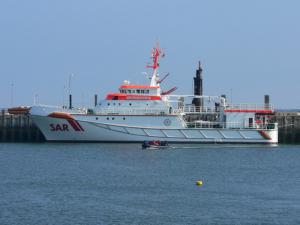Search & rescueMathematics helps search and rescue ships sail more safely in heavy seas
Fast ships deliver all kinds of services in fields such as disaster response, the fight against crime, the provision of supplies for oil and gas platforms, and the transportation of wind farm maintenance personnel. Each year, however, around 100 such ships worldwide are lost or damaged in heavy seas, with around 2,500 casualties in 2013. A unique new computer model built on highly complex mathematics could make it possible to design safer versions of the “fast ships” widely used in search-and-rescue, anti-drugs, anti-piracy, and many other vital offshore operations.

A search and-rescue vessel at dock // Source: wikimedia.org
A unique new computer model built on highly complex mathematics could make it possible to design safer versions of the “fast ships” widely used in search-and-rescue, anti-drugs, anti-piracy, and many other vital offshore operations.
Travelling at up to 23-30 knots, fast ships are especially vulnerable to waves that amplify suddenly due to local weather and sea conditions — extreme funneling effects, for example, may turn waves a few meters high into dangerous waves tens of meters tall that can destabilize ships, resulting in damage, causing injuries and threatening lives.
Developed with Engineering and Physical Sciences Research Council (EPSRC) support at the University of Leeds by Dr. Anna Kalogirou and Dr. Vijaya Ambati with Professor Onno Bokhove, the new model produces unprecedentedly accurate animations and simulations that can show exactly how sea waves can affect fast ships. It highlights the importance of having accurate predictions of the pressure forces that these craft are subjected to, and could aid the design of fast ships better able to withstand the effects of rough seas.
EPSRC reports that the researchers can already simulate the complex interactions of sea waves that can lead to an anomalously high freak wave, but adding the motion of ships into the equation complicates matters significantly.
Kalogirou said: “We have managed to develop a simulation tool that uses sophisticated mathematical methods and produces fast and accurate simulations of linear wave-ship interactions. Our tool can also provide measurements in terms of wave amplitudes around ships, as well as pressures on ships’ surfaces.”
The aim is to extend the model over the next three years to produce a tool that can be used extensively by ship designers and maritime engineers.
The model has been validated through laboratory experiments on a man-made freak or rogue wave (the so-called “soliton splash”) using test tanks. A comparison with wave and ship motion, for a ship moored on two anchors, has been set up in a small test tank, which is also used for public demonstrations.
Results from the project are being disseminated to a range of organizations including the Maritime Research Institute Netherlands (MARIN). A related European Industry Doctorate project with MARIN on rogue and breaking waves against offshore structures has strengthened Bokhove’s EPSRC-funded research on wave impact against ships, as well as his EU-funded work on fixed offshore structures.
EPSRCnotes that fast ships deliver all kinds of services in fields such as disaster response, the fight against crime, the provision of supplies for oil and gas platforms, and the transportation of wind farm maintenance personnel. Each year, however, around 100 such ships worldwide are lost or damaged in heavy seas, with around 2,500 casualties in 2013.
Bokhove says: “Describing mathematically the complex behaviour of waves and their interaction with fast ships and then incorporating all of this into a robust computer model has been very challenging. We’re delighted to have provided further proof of how advanced mathematics can have real-world applications that help save money and safeguard lives.”
The 18-month project ‘FastFEM Behaviour of Fast Ships in Waves’ began in June 2014 and ended in December 2015, having received total EPSRC funding of just over £147,000.
— Videos of wave simulation can be found on this page, and also at researcher Anna Kalogirou’s YouTube channel; linear motion of a wave-energy buoy moving in driven shallow water waves; linear motion of a wave-energy buoy in driven potential flow water waves; small-scale realization of a potential wave-energy device; Benney-Luke nonlinear Soliton Splash simulation.
— Read more inO. Bokhove and A. Kalogirou, “Variational water wave modelling: from continuum to experiment (PDF),” in: T. Bridges, M. Groves, and D. Nicholls, eds., Lectures in the Theory of Water Waves. LMS Lecture Note Series (Cambridge University Press, 2016): 226-60; A. Kalogirou, O. Bokhove, and E. E. Moulopoulou (2016) “Variational finite element methods for waves in a Hele-Shaw tank,” Applied Mathematical Models (2016) (doi: 10.1016/j.apm.2016.02.036); A. Kalogirou and O. Bokhove, “Mathematical and numerical modelling of wave impact on wave-energy buoys,” Proceedings of the ASME 2016 35th International Conference on Ocean, Offshore and Arctic Engineering (OMAE2016) (19-24 June 2016, Busan, South Korea; in press); and A. Kalogirou, V.R. Ambati, and O. Bokhove “Variational linear, finite element dynamics of buoy and ship motion in water waves,” (2016; in preparation)
